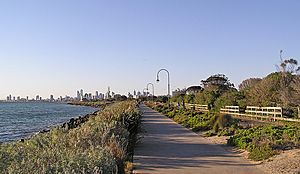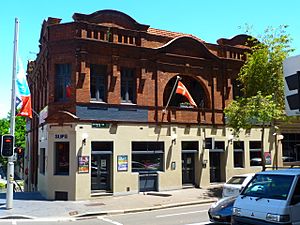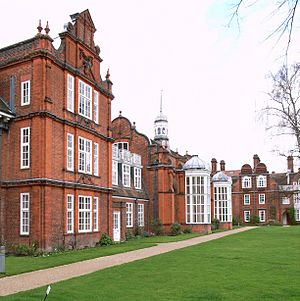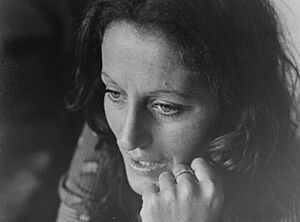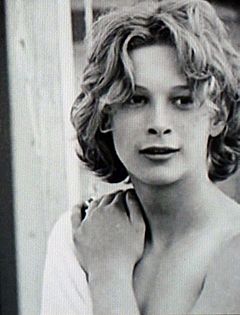Germaine Greer facts for kids
Quick facts for kids
Germaine Greer
|
|
|---|---|
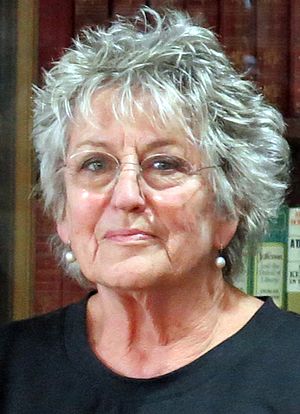
Greer at the University of Melbourne in 2013
|
|
| Born | 29 January 1939 |
| Education | |
| PhD thesis | The Ethic of Love and Marriage in Shakespeare's Early Comedies (1968) |
| Occupation | Writer |
| Years active | 1970–present |
| Era | Second-wave feminism |
|
Notable work
|
The Female Eunuch (1970) |
| Spouse(s) |
Paul du Feu
(m. 1968; div. 1973) |
Germaine Greer (born 29 January 1939) is an Australian writer and feminist. She is known as one of the most important voices in the second-wave feminism movement during the late 1900s. She has written many books and articles about women's rights and society.
| Top - 0-9 A B C D E F G H I J K L M N O P Q R S T U V W X Y Z |
Early Life and Education
Growing Up in Melbourne
Germaine Greer was born in Melbourne, Australia, on January 29, 1939. She grew up in a Catholic family. Her father, Reg Greer, was a newspaper advertising salesman. Her mother, Peggy, was a milliner, which means she made hats.
The family lived in the Melbourne suburb of Elwood. When Germaine was three years old, her father joined the army during World War II. He worked on secret codes for the British Royal Air Force in Egypt and Malta.
Germaine went to several Catholic primary schools in Melbourne. In 1952, she won a scholarship to Star of the Sea College, a convent school. She said her Catholic school helped her discover art and music. She did very well in her exams. A year after leaving school, she decided to leave the Catholic faith. She moved out of her family home when she was 18.
University Studies
Melbourne and Sydney
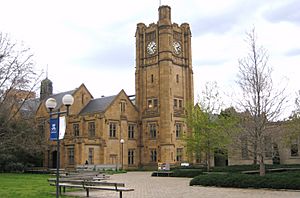
In 1956, Greer began studying English and French at the University of Melbourne. She lived at home for the first two years. After graduating in 1959, she moved to Sydney.
She then studied at the University of Sydney. She focused on the poet Lord Byron. While there, she also enjoyed acting. In 1963, she earned a master's degree (MA) for her work on Byron's writing style. She then became a senior tutor in English at the university.
Cambridge University
Her master's degree helped her win a special scholarship. This allowed her to continue her studies at the University of Cambridge in England.
At Cambridge, Greer joined the student acting group called the Footlights. She was one of the first women to become a full member. She performed in a show called My Girl Herbert in 1965.
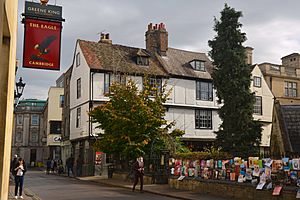
Greer speaks fluent Italian. She finished her PhD in Italy in 1968. She wrote her PhD paper on love and marriage in Shakespeare's early plays. Later, she wrote books about Shakespeare, including Shakespeare (1986) and Shakespeare's Wife (2007).
Career and Writing
From 1968 to 1972, Greer worked as a teacher at the University of Warwick in England. In 1968, she got married, but her marriage ended in divorce in 1973.
She also started working in television. She appeared in BBC shows like Good Old Nocker and Twice a Fortnight. She also starred in a short film. From 1968 to 1969, she was in a comedy show called Nice Time.
Greer has held teaching jobs at Newnham College, Cambridge, and the University of Tulsa in the United States. Since the 1990s, she has divided her time between Australia and her home in England.
Her first book, The Female Eunuch (1970), made her very famous. It became an international bestseller. In the book, she challenged common ideas about womanhood and femininity. Her ideas have often caused discussion and debate.
Greer has written more than 20 books. Her later works focus on literature, feminism, and the environment. Some of her other books include The Change (1991), The Whole Woman (1999), and The Boy (2003). Her 2013 book, White Beech: The Rainforest Years, is about her efforts to restore a rainforest area in Australia.
Besides her academic work and activism, she has written many articles for newspapers and magazines. She is known as a radical feminist, which means she believes in big changes to society to achieve women's freedom.
Awards and Recognition
Germaine Greer has received several special degrees from universities. These include honorary doctorates from York University (1999), the University of Melbourne (2003), Anglia Ruskin University (2003), and the University of Sydney (2005).
The National Portrait Gallery in London has bought several photos and a painting of Greer. In Australia, she was named a National Living Treasure in 1997. In 2001, she was added to the Victorian Honour Roll of Women. In 2011, she was one of four famous Australian feminists featured on Australian postage stamps.
In the UK, she was voted "Woman of the Year" in 1971. In 2016, BBC Radio 4's Woman's Hour placed her fourth on its "Power List" of women who had the biggest impact on women's lives over 70 years.
Germaine Greer Archive
In 2013, Germaine Greer sold her collection of writings and papers to the University of Melbourne. This collection, called an archive, covers her work from 1959 to 2010. It fills 487 boxes and takes up 82 meters of shelf space.
The university started moving the archive from Greer's home in England in 2014. They also announced they were raising money to buy, ship, store, and organize the collection. Greer said she would donate the money from the sale to her charity, Friends of Gondwana Rainforest.
Images for kids
-
Cave Creek, near Natural Bridge, Queensland
-
With Lewis Wolpert on Channel 4's After Dark, 1994
See also
 In Spanish: Germaine Greer para niños
In Spanish: Germaine Greer para niños


